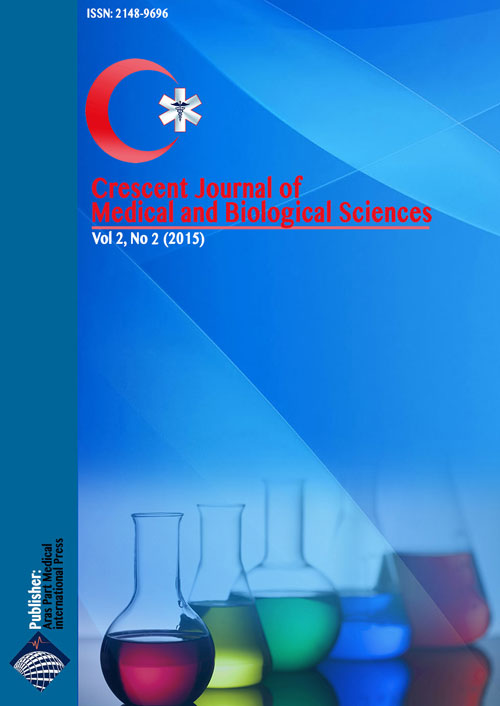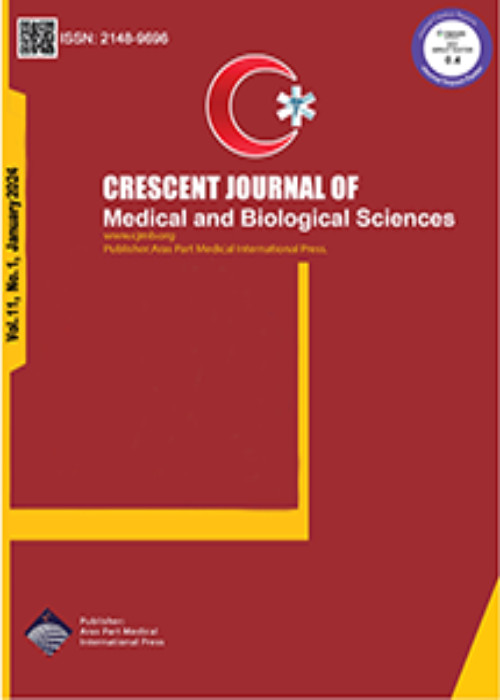فهرست مطالب

Crescent Journal of Medical and Biological Sciences
Volume:2 Issue: 2, Apr 2015
- تاریخ انتشار: 1394/04/12
- تعداد عناوین: 8
-
-
Pages 37-41ObjectiveEveryday use of various electronic tools and appliances has caused a large number of people to constantly be under the influence of electromagnetic fields (EMFs).Materials And MethodsFor the purpose of this study, 40 female rats were randomly selected from the animals’ laboratory. The rats chosen for the study were 3 months old and weighted 20 + 200 g. The animals were then randomly divided into 4 groups; Control (n = 10), Experiment 1 (n = 10), Experiment 2 (n = 10), and Experiment 3 (n = 10). During the experiment, all 4 groups were maintained in the same conditions and received the same feeding procedure. Test groups 1, 2, and 3 were under the influence of a 50 Hz EMF for 8 weeks. Subsequently, the second and third groups were kept away from the effects of EMF for another 8 weeks. At the end of the study, after removing the ovarian using glutaraldehyde, they were prepared for electron microscopy study. Ex2 group rats were not sacrificed, and were maintained for another 8 weeks in normal laboratory environment away from the impacts of EMF. The rats were fed vitamin E (100 mg/kg) and fennel extract (1.5 gr/kg/body weight) was added to their daily food. Samples were taken from this group at the end of the second 8 weeks. Samples from the Ex3 group were taken at the end of the second 8 weeks which were maintained in normal conditions without the use of vitamin E and fennel extract. The 10 rats from the control group were biopsied simultaneously with the Ex1 group sampling.ResultsThis study showed that in the groups that had been exposed to electromagnetic radiation, zona pellucida cells had lost their microvilli and mitochondrial crystal structure. In the groups that were exposed to vitamin E and fennel extract, these changes were reduced.ConclusionThe use of vitamin E in combination with fennel extract can reduce the damaging effects of non-ionizing radiation with 50 Hz frequency on the zona pellucida cells of rat ovaries.Keywords: Electromagnetic Field (EMF), Fennel, Ovary, Vitamin E
-
Pages 42-47ObjectiveFerula gummosa Boiss. (Apiaceae family), which has been used in traditional medicine of Iran as anti vaginal infection, anti-sinusitis, sedative, and anti-inflammation.Materials And MethodsIn this research, the gums of plant root were collected from the Heidary nature reserve in Razavi Khorasan Province (Iran) in August 2012. The ethnopharmacological data about traditional uses of plant were obtained from the rural healers (women 67-75 year) of this region. Essential oil of the plant root gum was obtained by hydrodistillation (Clevenger apparatus) and was analyzed by gas chromatography–mass spectrometry. Antibacterial activity of plant ethanolic extract was studied in vitro against Candida albicans and 9 Gram-positive and negative bacteria using well method and the minimum inhibitory concentration (MIC) assay.ResultsResults showed that a total of 39 components have been identified in the plant sampl oil, representing 81% of the total oil and β-pinene (19.88%), guaiol (8%), shyobunone (6.96%), delta-cadinene (4.65%), α-pinene (3.16 %), β-phellandrene (3.28%) and myrtenol (2.8%), were the main essential oil composition, respectively. The results from antibacterial screening (Table 2), were showed that C. albicans (25.2 ± 1.6), Staphylococcus epidermidis (23.6 ± 0.7 mm), Staphylococcus aureus (21.3 ± 0.2 mm), Escherichia coli (16.5 ± 0.8 mm), Bacillus cereus (19.5 ± 0.1 mm), Enterococcus faecalis (17.2 ± 0.8 mm) and Pseudomonas aeroginosa (17.8 ± 0.2 mm) inhibition zone and MIC (35.4-112 μg/ml) were the most sensitive pathogenes to the plant extract respectively, which followed Shigella (12.3 ± 0.3 mm) and Klebsiella pneumonia (12.5 ± 0.2 mm) were found to be moderate sensitive bacteria and then the Salmonella typhymorium which completely was resistant to plant root extract.ConclusionAccording to these results, it can be concluded that the extract of F. gummosa L. have suitable antimicrobial and anti-Candidacies activity, which can be used as natural anti-infection to treat of many infection diseases, especially in vaginal infection.Keywords: Candida, Ethnopharmacology, Essential, Ferula, Oils, Vaginitis
-
Pages 48-52ObjectiveEscherichia coli is the most important etiologic factor in urinary tract infection (UTI), which is becoming resistant to the common antibiotics. The aim of this study was to evaluate the resistance of this bacterium to the antibiotics that are commonly used.Materials And MethodsA descriptive study conducted in patients with uncomplicated UTI referring to Sari hospitals during 2013-2014. For this purpose, samples that had positive urine culture were selected and evaluated with antibiogram. In addition, E-Test MIC method was used for antibiotics ciprofloxacin and co-trimoxazole. SPSS software was used for data analysis.ResultsOf the 101 patients studied, 83 (82.2%) were females and 18 (17.8%) were male. The mean age of patients was 40.32 ± 3.22 years. The most sensitivity was seen to nitrofurantoin (92.07%), gentamicin (76.23%). Most resistance was also seen to the antibiotics amoxicillin (74.25%), co-trimoxazole (64.35%) and ciprofloxacin (36.63%). In E-Test MIC method, 23.7% were resistant to the ciprofloxacin and 43.5% to co-trimoxazole.ConclusionDue to the high antibiotic resistance that was observed to ciprofloxacin and co-trimoxazole in this study, it seems a better alternative antibiotic such as nitrofurantoin should be used for the empirical treatment of patients with UTIs.Keywords: Antibiotic, Antimicrobial Resistance, Escherichia coli, Urinary Tract Infection
-
Pages 53-58ObjectiveThe purpose of this study was to investigate the relationship between premenstrual syndrome (PMS) and physical activity, aerobic power, and anaerobic power in female high school students.Materials And MethodsA total of 367 female high school students were selected randomly from district 5 of Tehran. Among them, 40 students who had the highest PMS score and all the inclusion criteria of the study were selected as subjects. The level of physical activity was assessed using the Baecke Physical Activity Questionnaire and PMS was assessed using a self-report questionnaire. Aerobic power was assessed using submaximal 1-mile track jog test. Pearson’s correlation coefficient was used for analyzing the relationship between variables.ResultsThe results indicated a significant negative correlation between PMS and physical activity (r = -0.86 and P < 0.05) and aerobic power (r = -0.71 and P < 0.05).ConclusionBased on the findings, it seems that regular physical activity, especially aerobic activities, can be effective in reducing the symptoms of PMS.Keywords: Exercise Test, Physical Activity, Premenstrual Syndrome (PMS)
-
Pages 59-63ObjectiveThe Foeniculum vulgare (FVE), known as fennel, has a long history of herbal uses as both food and medicine. The seed of this plant has been used to promote menstruation, alleviate the symptoms of female climacteric, and increase the number of ovarian follicles. The aim of this study was to evaluate the fennel extract effects on serum level of oxidative stress in female mice.Materials And MethodsTotally, 28 virgin female albino mice were divided into four groups (n = 7). Groups 1 and 2 (experimental groups) were administered FVE at 100 and at a concentration of 100 and 200 mg/kg for 5 days, interaperitoneally. Group 3 (negative control) received ethanol and Group 4 (positive control) received normal saline. Animals were scarified at 6th day, sera were collected and the level of oxidative stress was determination of using total antioxidant status kit.ResultsData analysis revealed that there is a significant difference in the mean level of serum oxidative stress between four different groups. P value in experimental groups compared to the control group was (P < 0.0001).ConclusionFennel extract can decrease the serum level of oxidative factors in female mice; it can be introduced as a novel medicine for treatment of infertilityKeywords: Foeniculum vulgare, Infertility, Mice, Oxidative Stress
-
Pages 64-68ObjectiveNoise as a natural teratogenic factor affects the body systems including the reproductive organ to reduce the fertility rate and fetus health. Honey and vitamin E as natural antioxidants protects the sperm released from the reproductive system. This study was conducted to examine the efficacy of honey and vitamin E on fertilization capacity in noise-exposed rats by assessing plasma sexual hormones levels i.e., follicle-stimulating hormone (FSH), luteinizing hormone (LH), and testosterone, altered in relation with noise stress.Materials And MethodsThis study was targeted the 24 male rats that randomly were divided into four equal groups including one control group (unexposed to noise stress) and three experimental groups pre-induced with noise stress for 50 days and then divided as: no treated, honey and vitamin E treated groups, respectively. Then, the blood samples of experimental and control groups were taken, and the serum level of the sexual hormones was analyzed. Finally, to investigate the fertility capacity of rats, the male rats of all groups were coupled with the female ones.ResultsOur results showed that FSH and LH level in noise stressed male rats raised, and the testosterone secretion decreased compared to the control group. Moreover, noise stress injury could reduce weight and the survival rate of the fetus. However, the honey and vitamin E improved the testosterone concentration, declined the plasma FSH and LH level in noise - exposed rats and enhanced the fertility rate.ConclusionThese findings may also spell out a natural curative approach rather than pharmaceutical drugs to optimize of neuroendocrine gonadal axis and testicular integrity induced by pathogenesis stress, i.e., noise and enhance the male fertility capacity.Keywords: Gonadal Hormones, Honey, Noise, Vitamin E
-
Pages 69-70


